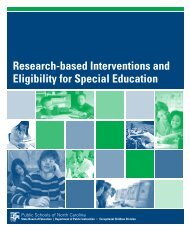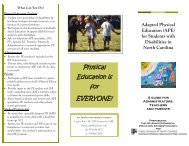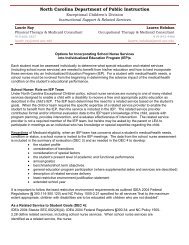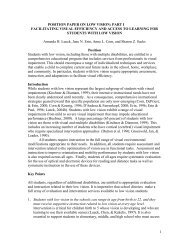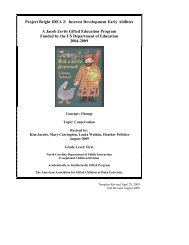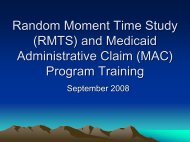Performance Appraisal Instrument for Educational Interpreter/Cued ...
Performance Appraisal Instrument for Educational Interpreter/Cued ...
Performance Appraisal Instrument for Educational Interpreter/Cued ...
You also want an ePaper? Increase the reach of your titles
YUMPU automatically turns print PDFs into web optimized ePapers that Google loves.
PERFORMANCE APPRAISAL INSTRUMENTEDUCATIONAL INTERPRETER/CUED LANGUAGE TRANSLITERATOR<strong>Interpreter</strong>/Transliterator Name:School:I. INTERPERSONAL RELATIONS1. Demonstrates flexibility in meeting new and different situations.1 2 3 4 5 62. Exhibits positive attitude and interacts effectively with students, parents and staff.1 2 3 4 5 63. Accepts corrective criticism and suggestions.1 2 3 4 5 64. Communicates effectively with members of the educational team.1 2 3 4 5 65. Works well as a team member.1 2 3 4 5 66. Cooperates with school personnel.1 2 3 4 5 6COMMENTS:II.PROFESSIONAL DEVELOPMENT1. Demonstrates a commitment to personal and professional growth.1 2 3 4 5 62. Participates in workshops, seminars, conventions, lectures, etc.1 2 3 4 5 63. Participates in in-services.1 2 3 4 5 64. Uses time constructively during workdays and student absences to enhance professional development.(See Job Description 2, 3 and 8)1 2 3 4 5 6COMMENTS:Draft Revised 5/00
III.GENERAL PROFESSIONAL COMPETENCIES1. Carries out assigned responsibilities.1 2 3 4 5 62. Works well without direct supervision.1 2 3 4 5 63. Follows school policies and implements the proper chain of command.1 2 3 4 5 64. Maintains high professional standards in compliance with federal, state and school district policies.1 2 3 4 5 65. Adheres to the school dress code in accordance with the RID Code of Ethics1 2 3 4 5 66. Punctuality. Arrives on time and is prepared <strong>for</strong> class. WHICH ONE?1 2 3 4 5 67. Uses good judgment (when emergencies arise. = YES OR NO?)1 2 3 4 5 6COMMENTS:IV.SPECIFIC PROFESSIONAL COMPETENCIES1. Adheres to the RID Code of Ethics and <strong>Cued</strong> Language Code of Conduct.1 2 3 4 5 62. Participates and adheres to the IEP.1 2 3 4 5 63. Works to foster independence in the deaf/hard of hearing students.1 2 3 4 5 64. Uses “downtime” or planning time appropriately.1 2 3 4 5 65. Exhibits Cultural and interpersonal knowledge skills <strong>for</strong> interpreting/transliterating.1 2 3 4 5 6COMMENTS:Draft Revised 5/00
V. INTERPRETING COMPETENCIESA. Sign-to-Voice1 = Main ideas and details are not desirable.2 = Main ideas conveyed and some details understood.3 = Main ideas and details conveyed.B. Voice-to-Sign1 = Main ideas and details are not desirable.4 = Main ideas conveyed and some details understood.5 = Main ideas and details conveyed.COMMENTS:Evaluator’s Summary Comments:<strong>Educational</strong> <strong>Interpreter</strong>/<strong>Cued</strong> Language Transliterator’s Response to Evaluation:Evaluator’s SignatureDate<strong>Interpreter</strong>/Transliterator’s SignatureDateSignature indicates that the written evaluation has been seen and discussed.Draft Revised 5/00
SIGN SKILLS OBSERVATION FEEDBACK GUIDEEDUCATIONAL INTERPRETER LANGUAGE TRANSLITERATOR<strong>Interpreter</strong>/Transliterator Name:School:Class:Content:I. SIGN-TO-VOICEA. Message Comprehension1. Fingerspelling and number recognition2. Sign Recognition3. Gesture/Mime/Non-Manual Marker recognition4. Concept RecognitionCOMMENTS:B. Message Transmission1. Accuracy of the message such as whole message presented. No inappropriate deletions,substitutions, or extraneous in<strong>for</strong>mation added.2. Appropriate in<strong>for</strong>mation added to alleviate cultural or linguistic differences.3. English Grammar Structure such as appropriate tense, syntax.4. Vocabulary Selection – accurately conveys meaning and affect of speaker and knowledge of contentspecific vocabulary.5. Gestures/Mime/Non-verbal behaviors – can convey equivalent meaning in EnglishCOMMENTS:C. Vocal Production1. Speech production – rate and rhythm2. Volume3. Intonation – matches mood, feeling, affect of the speaker4. Stress/Emphasis – words and phrases are appropriately stressed5. Fluency – no awkward pauses; message is cohesiveCOMMENTS:D. Other1. Time-lag appropriate <strong>for</strong> comprehending and relaying the message2. Error recovery3. Self-assurance4. Voices at appropriate time and can recognize when communication is directed to the interpreter <strong>for</strong>clarification of the interpreted message as opposed to clarification or comment about the content, orwhen student is “mumbling” to themselves, etc.COMMENTS:Draft Revised 5/00
II. VOICE-TO-SIGNA. SIGN PRODUCTION1. Sign Vocabulary/Conceptsa. Knowledge – extensive knowledge of sign vocabulary/conceptsconceptually accurate.b. Utilization – Vocabulary consistent with targeted communicationmode, region, and registerc. Production by using correct handshape, palm orientation, movement,and location: appropriate directionality and have fluid movements ofsigns.d. Development of signs – sign invented follows ASL principals and appropriatepresentation of invented sign vocabulary.e. Inflection – sign production inflected <strong>for</strong> adjective intensity, adverbial in<strong>for</strong>mation,temporal aspect.2. FingerspellingAccuracy, Clarity, Appropriate Hand Positioning, Fluency – rhythm and pace3. NumbersAccuracy, Clarity, Appropriate Hand Positioning, FluencyCOMMENTS:B. NON-MANUAL FEATURES1. Mouthing – appropriate mouthing of fingerspelled words2. Eye Contact/Eye Gaze – uses eye gaze appropriately <strong>for</strong> characterization,promotional, identification of speaker3. Signing spacea. Overall signing space is appropriate – not positioned too high or low ortoo smallb. Pronominal – correct establishment and reference to pronounsc. Comparison/contrast/sequence/cause and effectd. Clustering in<strong>for</strong>matione. Location/relation using ASL classifier system4. Facial/Body Expressiona. Conveys speaker’s mood tone, and feelingsb. Appropriate eyebrow grammar to indicate topic/comment structures, clauses, etc.c. Use of pantomime to clarify message5. Role Positioning6. Questioning by using appropriate eyebrow grammar <strong>for</strong> Wh, Yes/No, and Rhetorical QuestionsCOMMENTS:C. INTERPRETED MESSAGE1. Message Transmissiona. Message conveyed accurately no inappropriate deletions, substitutions, orextraneous addedb. Main idea and details were conveyed clearlyc. Appropriate in<strong>for</strong>mation added to alleviate cultural or linguistic differencesd. Contextual strategies implemented when necessary (circled)Draft Revised 5/00
2. FluencyCOMMENTS:D. OTHERCOMMENTS:Demonstrate Facing Elaboration ComparingReferencing/classifying Contrasting LabelingReiterationNarration-CharacterizationOthera. Smooth transition between signs – not choppy; no hesitations or sign “stuttering”b. Stress/emphasis – <strong>for</strong> important words or phrasesc. Affect/emotion – rate and style of signing reflects affect and emotion of speakerd. Boundaries/clustering sentence, clauses, and concept boundaries represented and use ofappropriate pausing1. Time lag by allow adequate time allowed to comprehend the message be<strong>for</strong>e signing2. Error recovery – can appropriately revise or amend a previously3. Request <strong>for</strong> Clarification – requests <strong>for</strong> clarification from speaker are polite and concise4. Mannerisms – movements distracting to observer (readjusting glasses, fixing hair,swaying, etc.)5. Environmental In<strong>for</strong>mation by Indication of speakers and conveys appropriateenvironmental soundsIII.ASPECTS SPECIFIC TO INTERPRETINGa. Appropriate ASL Syntaxb. Appropriate use of ASL mouth morphemesc. Appropriate use of classifiers and size and space specifiesCOMMENTS:IV.SPECIFIC TO TRANSLITERATINGa. Follows English syntaxb. Use of English morphological markersc. Clearly articulates speaker’s EnglishCOMMENTS:Evaluator’s Summary Comments:Draft Revised 5/00
I. CUED LANGUAGE TRANSLITERATOR ASSESSMENT, TECHNICALa. handshapes are accurateb. handshapes placements are accuratec. mouth moves accurately with handd. delivers message in an appropriate manner, matching needs of the cliente. if paraphrasing, delivers the concept accuratelyf. appropriately includes environmental soundsg. appropriately delivers pronunciationsh. appropriately delivers mood and affecti. appropriately designates speakersj. maintains appropriate eye contactk. when transliterating receptively, designates self and cues while voicingl. maintains standards according to the Code of Conduct published by the TEC unit<strong>Educational</strong> <strong>Interpreter</strong> Response to Evaluation:Evaluator’s SignatureDate<strong>Interpreter</strong>/Transliterator’s SignatureDateSupervisor’s SignatureDateSignature indicates that the written evaluation has been seen and discussed.Draft Revised 5/00








